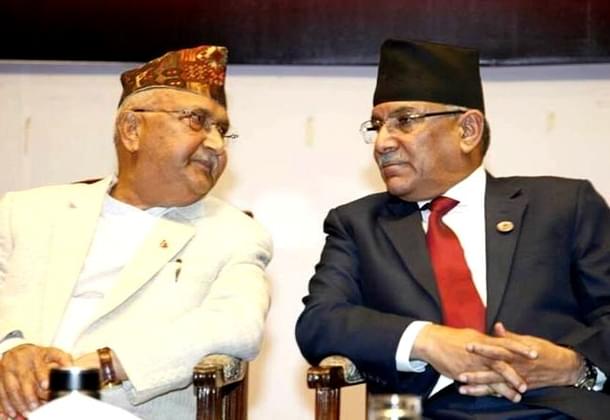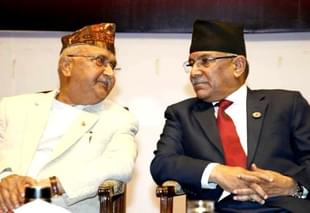World
Explained: How China’s Plans To Gain Primacy In Nepal Seems To Be Unravelling With Crisis In Nepal Communist Party
Jaideep Mazumdar
Nov 06, 2020, 03:51 PM | Updated 03:49 PM IST
Save & read from anywhere!
Bookmark stories for easy access on any device or the Swarajya app.


Earlier this week, news of Nepal Prime Minister Khadga Prasad Sharma Oli’s threat to split his ruling Nepal Communist Party (NCP) if pushed to the wall by his party rivals shocked the Himalayan country.
Since then, leaders of the various factions of the deeply-divided party have made frantic efforts to stave off an imminent crisis. Even the country’s President, Bidya Devi Bhandari, had intervened to avert a split in the party (read this).
But none of that seems to be working. A last-ditch effort by the two top leaders of the NCP — Oli and party co-chair Pushpa Kamal Dahal — to resolve their differences ended inconclusively on Thursday (5 November) afternoon.
The Oli-Dahal Rift
Oli and Dahal have been at loggerheads with each other for over a year now. Dahal has long resented Oli’s unilateral style of functioning.
Dahal has been arguing that the government has to be subservient to the party and should follow party directives and decisions. But Oli has been disregarding the wishes of the party.
Matters came to a head last year, but the crisis was resolved in end-November with Dahal being made the executive chairman of the party and Oli getting a free hand to run the government for the full five-year term.
Dahal had also resented the violation of a ‘gentleman’s agreement’ between him and Oli that said the two would share the Prime Minister’s post (read this).
This agreement was reached between the two a day prior to the formal unification of Dahal’s Communist Party of Nepal (Maoist Centre) or (CPN-MC) and Oli’s Communist Party of Nepal (Unified Marxist-Leninist) (CPN-UML) in May 2018.
The NCP came to power after sweeping the federal and provincial elections held in November-December 2017 and Oli became the Prime Minister in February 2018. But he remained the co-chair of the party.
As per the ‘gentleman’s agreement’, Oli ought to have stepped down as Prime Minister after completing 2.5 years in office in August 2020.
But even as he completed 15 months — half his term of 2.5 years — in office, Oli started hinting that he would not adhere to the agreement.
That was not the first time, however, that Oli signalled his intention to violate a power-sharing agreement with Dahal. In June 2016, too, Oli had refused to honour a similar deal to step down in Dahal’s favour.
That had led to Dahal pulling out of the coalition government (between his party and Oli’s CPN-UML and joining hands with the opposition Nepali Congress to form a new government in 2016.
The Latest Crisis
The underlying tension and power play between the two leaders locked in a mutually suspicious relationship erupted into a full-blown crisis in April-May this year with Dahal joining hands with other senior NCP leaders like former prime ministers Madhav Kumar Nepal and Jhala Nath Khanal, and former deputy prime minister Bamdev Gautam, to unseat Oli.
With the NCP seniors ganging up against Oli, the latter found himself outnumbered in the party’s secretariat and standing committees.
Dahal, emboldened by the fact that a majority of the members of the party secretariat, the standing committee and the central committee had rallied behind him, called for Oli’s resignation in July this year.
But Oli refused to pay heed and the crisis escalated. The border row with India came in handy for Oli and he adopted a hardline nationalist stance which kept his adversaries at bay, but for a short while.
But that crisis was also averted with Oli and Dahal reaching yet another agreement on 11 September.
Under this agreement, Oli committed himself to handing Dahal full executive powers to run the party in return for being allowed to run the day-to-day affairs of the government without any interference from the party.
However, Oli promised to go by the party’s advice on important issues. Oli also agreed to consult the party before making major appointments.
But even before the ink on this agreement dried, Oli started violating it. Oli unilaterally appointed some ministers and ambassadors to major countries. This infuriated Dahal.
Dahal, in a show of displeasure, kept himself away from his customary daily meetings with Oli. And when he ultimately met Oli after a gap of 11 days on Saturday (31 October), Dahal was in for a shock.
Dahal told his party colleagues (read this) that Oli categorically told him that he (Oli) won’t abide by any decisions of the party and if anyone has any problem with that, “it is better to part ways”.
Oli reportedly told Dahal that it would be wiser to “go their separate ways instead of dragging on with their differences”. Oli also warned Dahal that if he is cornered, he would take some “big action” (read this).
While a split in the NCP may be averted yet again, what is clear is that the deep fissures within the ruling party will remain. Primarily because the merger between the CPN-MC and CPN-UML was an unnatural one.
Setback For China
This (the failure of the merger) represents a huge setback for China because it was Beijing which had brokered the unification of the two communist parties with disparate ideologies and interests.
When the merger of the two parties was first announced in early October 2017, it took everyone by surprise.
The NCP is yet to agree on a party constitution and adopt a coherent ideology. Basic differences between the two parties remain.
While members of the CPN(UML) want the NCP to adopt their party’s ‘people’s multi-party democracy’, the Maoists want a ‘21st century people’s democracy’ (a euphemism for one-party rule).
Many in the CPN(UML) also want the NCP to dissociate itself from the ‘people’s war’ that the Maoists waged for a decade and that resulted in the deaths of more than 17,000 people.
NCP standing committee member Mani Thapa says the merger of the two parties was a “marriage of convenience between two incompatible partners unsuited to each other”. He says that this marriage was doomed from the beginning.
Many in the NCP, especially those belonging to the erstwhile CPN(UML), echo Thapa. “It (the merger) was agreed to by Oli and Dahal in order to grab power for their personal gains,” said a central committee member who did not want to be named.
And why did Beijing broker the merger? Because it calculated that it would be able to make Nepal do its bidding once the new party (NCP) comes to power.
At the time of the merger (2017), the Nepali Congress (NC) was in disarray and was largely discredited.
China calculated, and rightly, that if the two communist parties in Nepal fought against each other, the NC would benefit. And if the two communist parties merged, the new party would sweep the elections.
That is exactly what happened. And once the NCP was in the saddle, China started expanding its footprints in the Himalayan country.
What Beijing did not reckon was that personal ambitions of some would derail its plans. It also failed to understand that the disparate, and even opposing, ideologies of the Maoists and CPN(UML) would make a merger unsustainable.
This is exactly what seems to be happening. Oli appears to have realised that his ideological differences with Dahal makes the two of them incompatible.
Political pundits in Nepal say that if the NCP splits, Chinese ambitions in Nepal would take an embarrassing blow.
What needs to be kept in mind in the context of Oli’s warning and ultimatum to Dahal is that the Nepal Prime Minister held a closed door, two-hour-long meeting with Samant Kumar Goel, the head of India’s external intelligence agency Research & Analysis Wing (R&AW) a few days before he met Dahal.
And that official engagements between the two countries (India and Nepal) have suddenly resumed. The dragon’s advance in Nepal seems to have been contained.
Jaideep Mazumdar is an associate editor at Swarajya.




